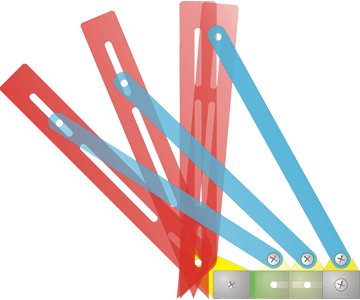How
to Make
Variable Angle Magnetic Fixtures
 Soon after I made my first
magnetic fixtures I began pondering how to make
variable angle fixtures for times when I need to
jig something that isn't 90° to the building board. For example,
most flying boat hulls have angled sides. Soon after I made my first
magnetic fixtures I began pondering how to make
variable angle fixtures for times when I need to
jig something that isn't 90° to the building board. For example,
most flying boat hulls have angled sides.
I always had in my mind that the worst case would be making fixtures
specific to the project that are cut at the correct angle for whatever is
being jigged. That approach isn't very efficient and I'd probably
never use the fixtures for anything else but I'd be able to complete the
project.
From the time I began building with
magnets to this day I haven't had a project requiring a fixture at an
angle other than 90°. What it came down to was I had challenged myself
to come up with a solution even though I didn't have a use for them.
Over the past several years I've tried a couple approaches starting with
what seemed to be the simplest. All my initial attempts were
variations of the same idea — cut a radiused
slot that allows the fixture to rotate on the bolts that secure the magnet.
I've cut slots like this in the past for other purposes and they never came
out very good. I've tried rotating the piece on a pin and using a
scroll saw but the blade wandered all over. I've done the same
thing using my
router
table with equally poor results. I've also just cut free-hand on
my scroll saw and it was better but still not good.
|
In regard to the fixtures, even when the slot was useable
the idea simply didn't work for several reasons:
-
The fixture didn't rotate smoothly due to the poorly cut slot. This
made it difficult to set the required angle.
-
The range was very limited. I don't remember the exact number but I
think at most I could get somewhere in the 20° to 30° range. That
probably would have been fine for most practical purposes but I wanted the
fixtures to have a wider range.
-
The fixture face didn't come all the way to the board because the edge of
the fixture needed to be radiused to allow the fixture to rotate.
-
For reasons I still haven't determined, the fixture had no holding power at
all. Even the slightest bit of force lifted the magnets from the
board. I tried arranging the magnets differently, adding more magnets
and more steel poles but the result was always the same. I'm guessing
the force against the fixture just had more leverage than the closely spaced
magnets could withstand.
The radiused slot approach was a failure and I gave up on it. Up to
then I wasn't real concerned about the rotational range or size of the
fixture. I just wanted a starting point that I could build from.
What I realized is that the fixture wasn't going to be a simple one-piece
affair.
I was, however, confident that a triangle with three adjustable angles would
work but would also be much more complicated and require working out the
geometry. So that's what I did. A specification was no longer
optional but it was pretty simple:
-
The fixture must have unlimited adjustment range from 45° to 135°.
-
The wider the base, the more rigid and stable the fixture will be. I arbitrarily
decided that the maximum width of the fixture base must not exceed 6" at any angle
setting because it didn't seem unreasonable to have a building board 12"
wider than whatever is being built.
-
The fixture face must touch the board at any angle to fully support the item
being jigged.
-
The angle must be securely locked in place once set.
-
The fixture must have reasonable holding power, e.g. can not pop loose from
the steel board too easily.
My final design is the
simplest that I could make work well.
This project doesn't require parts to be fabricated to extremely accurate
tolerances. However, the more accurate everything is the better it
will work. The movement will be smoother and there will be less play
which will make it much easier to set the required angle accurately.
I made one prototype. It worked very well so I went on to make four
more fixtures with slight revisions. As soon as they were done I
realized that the hardware could be changed to make the fixture much easier
to work with and I made another four fixtures.
|
![]()